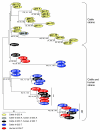Phylogenetic classification of Escherichia coli O157:H7 strains of human and bovine origin using a novel set of nucleotide polymorphisms
- PMID: 19463166
- PMCID: PMC2718522
- DOI: 10.1186/gb-2009-10-5-r56
Phylogenetic classification of Escherichia coli O157:H7 strains of human and bovine origin using a novel set of nucleotide polymorphisms
Abstract
Background: Cattle are a reservoir of Shiga toxin-producing Escherichia coli O157:H7 (STEC O157), and are known to harbor subtypes not typically found in clinically ill humans. Consequently, nucleotide polymorphisms previously discovered via strains originating from human outbreaks may be restricted in their ability to distinguish STEC O157 genetic subtypes present in cattle. The objectives of this study were firstly to identify nucleotide polymorphisms in a diverse sampling of human and bovine STEC O157 strains, secondly to classify strains of either bovine or human origin by polymorphism-derived genotypes, and finally to compare the genotype diversity with pulsed-field gel electrophoresis (PFGE), a method currently used for assessing STEC O157 diversity.
Results: High-throughput 454 sequencing of pooled STEC O157 strain DNAs from human clinical cases (n = 91) and cattle (n = 102) identified 16,218 putative polymorphisms. From those, 178 were selected primarily within genomic regions conserved across E. coli serotypes and genotyped in 261 STEC O157 strains. Forty-two unique genotypes were observed that are tagged by a minimal set of 32 polymorphisms. Phylogenetic trees of the genotypes are divided into clades that represent strains of cattle origin, or cattle and human origin. Although PFGE diversity surpassed genotype diversity overall, ten PFGE patterns each occurred with multiple strains having different genotypes.
Conclusions: Deep sequencing of pooled STEC O157 DNAs proved highly effective in polymorphism discovery. A polymorphism set has been identified that characterizes genetic diversity within STEC O157 strains of bovine origin, and a subset observed in human strains. The set may complement current techniques used to classify strains implicated in disease outbreaks.
Figures






Similar articles
-
Phylogeny of Shiga toxin-producing Escherichia coli O157 isolated from cattle and clinically ill humans.Mol Biol Evol. 2012 Aug;29(8):2047-62. doi: 10.1093/molbev/mss072. Epub 2012 Feb 21. Mol Biol Evol. 2012. PMID: 22355013 Free PMC article.
-
Genetic features of human and bovine Escherichia coli O157:H7 strains isolated in Argentina.Int J Med Microbiol. 2016 Feb;306(2):123-30. doi: 10.1016/j.ijmm.2016.02.005. Epub 2016 Feb 22. Int J Med Microbiol. 2016. PMID: 26935026
-
PFGE for Shiga toxin-producing Escherichia coli O157:H7 (STEC O157) and non-O157 STEC.Methods Mol Biol. 2015;1301:171-89. doi: 10.1007/978-1-4939-2599-5_15. Methods Mol Biol. 2015. PMID: 25862057
-
Comparison of Three Molecular Subtyping Methods among O157 and Non-O157 Shiga Toxin-Producing Escherichia coli Isolates from Japanese Cattle.Jpn J Infect Dis. 2018 Jan 23;71(1):45-50. doi: 10.7883/yoken.JJID.2017.297. Epub 2017 Dec 26. Jpn J Infect Dis. 2018. PMID: 29279448
-
Escherichia coli O157:H7 strains in bovine carcasses and the impact on the animal production chain.Braz J Microbiol. 2023 Sep;54(3):2243-2251. doi: 10.1007/s42770-023-01034-x. Epub 2023 Jun 19. Braz J Microbiol. 2023. PMID: 37335430 Free PMC article. Review.
Cited by
-
Escherichia coli O157:H7 tir 255 T > A allele strains differ in chromosomal and plasmid composition.Front Microbiol. 2023 Dec 15;14:1303387. doi: 10.3389/fmicb.2023.1303387. eCollection 2023. Front Microbiol. 2023. PMID: 38169669 Free PMC article.
-
Comparison of whole genome sequences from human and non-human Escherichia coli O26 strains.Front Cell Infect Microbiol. 2015 Mar 11;5:21. doi: 10.3389/fcimb.2015.00021. eCollection 2015. Front Cell Infect Microbiol. 2015. PMID: 25815275 Free PMC article.
-
Genomic-based identification of environmental and clinical Listeria monocytogenes strains associated with an abortion outbreak in beef heifers.BMC Vet Res. 2020 Feb 22;16(1):70. doi: 10.1186/s12917-020-2276-z. BMC Vet Res. 2020. PMID: 32087722 Free PMC article.
-
Differences between predicted outer membrane proteins of genotype 1 and 2 Mannheimia haemolytica.BMC Microbiol. 2020 Aug 12;20(1):250. doi: 10.1186/s12866-020-01932-2. BMC Microbiol. 2020. PMID: 32787780 Free PMC article.
-
Large genomic differences between Moraxella bovoculi isolates acquired from the eyes of cattle with infectious bovine keratoconjunctivitis versus the deep nasopharynx of asymptomatic cattle.Vet Res. 2016 Feb 13;47:31. doi: 10.1186/s13567-016-0316-2. Vet Res. 2016. PMID: 26872821 Free PMC article.
References
-
- Griffin PM, Tauxe RV. The epidemiology of infections caused by Escherichia coli O157:H7, other enterohemorrhagic E. coli, and the associated hemolytic uremic syndrome. Epidemiol Rev. 1991;13:60–98. - PubMed
-
- Hayashi T, Makino K, Ohnishi M, Kurokawa K, Ishii K, Yokoyama K, Han CG, Ohtsubo E, Nakayama K, Murata T, Tanaka M, Tobe T, Iida T, Takami H, Honda T, Sasakawa C, Ogasawara N, Yasunaga T, Kuhara S, Shiba T, Hattori M, Shinagawa H. Complete genome sequence of enterohemorrhagic Escherichia coli O157:H7 and genomic comparison with a laboratory strain K-12. DNA Res. 2001;8:11–22. doi: 10.1093/dnares/8.1.11. - DOI - PubMed
-
- Perna NT, Plunkett G, 3rd, Burland V, Mau B, Glasner JD, Rose DJ, Mayhew GF, Evans PS, Gregor J, Kirkpatrick HA, Pósfai G, Hackett J, Klink S, Boutin A, Shao Y, Miller L, Grotbeck EJ, Davis NW, Lim A, Dimalanta ET, Potamousis KD, Apodaca J, Anantharaman TS, Lin J, Yen G, Schwartz DC, Welch RA, Blattner FR. Genome sequence of enterohaemorrhagic Escherichia coli O157:H7. Nature. 2001;409:529–533. doi: 10.1038/35054089. - DOI - PubMed
Publication types
MeSH terms
Substances
LinkOut - more resources
Full Text Sources
Medical

